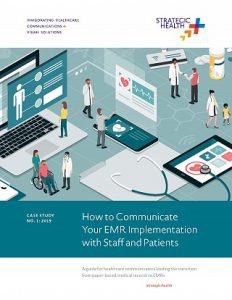How to Write a White Paper in Reverse
3 Traits Every Thought Leadership Source Should Have
October 7, 2018The usual way to write a white paper for a client is to interview the sources and then write the white paper.
But what happens when your sources aren’t available? Does the project stop altogether?
I worked with Strategic Health, a marketing agency specializing in healthcare, on a white paper designed to help healthcare marketing managers communicate the switch from paper-based records electronic medical records (EMRs). The project included creating blog posts based on the white paper once it was published.
We were all ready to go:
- We had a white paper action plan, which documented the possible titles for the white paper, the content sections, the review process, the research, etc.
- We had identified sources who had been through an EMR transition.
- We had a timeline!
And then … our sources fell through. Our choices were to sit on the project while we found more sources or start the project some other way. Since my client wanted content sooner rather than later, I suggested we start with the blog posts first. We could always backfill with info from sources later.
Here’s how we did it.
1.You Still Need a Content Plan
If you’re going to go in reverse – starting with blog posts and then weaving them into a cohesive document later – you need a good plan to start with.
I use a white paper action plan, which breaks down the content sections of a white paper, so we knew what direction to take. Without a plan, this would have been a dicey way to move forward, because if you write about whatever strikes your fancy, then it will be tough to tie everything together later.
The plan also had suggested keywords that I could use to populate blog posts.
Point being, a plan made it easy to approach each section as a separate blog post.
2. Blog Posts Are Different Than White Papers
Blog posts have their own rules. They need good headlines, SEO and CTAs. And each post has to stand on its own.
Also, blog posts have a certain format. Lists are especially popular. Therefore, we decided that each post would provide a series of tips supporting the main topic, whether it was what to do before the EMR implementation or how to listen to staff fears.
Once I wove them into a white paper, which would be published as a PDF, the keyword repetition was less important. We removed the CTAs as well. But we kept the headlines and the list format, because they seemed to work so well.
3. You Still Need a Good Source
Strategic Health helps healthcare marketing departments strategize and design marketing communication initiatives. Stephanie Helline, Strategic Health owner, once worked for Kaiser and has been in this space a long time.
With her longtime experience in healthcare communications, I suggested we use her as the initial source for the content. Yes, having other healthcare marketing managers as sources is ideal, but we could make good progress using Stephanie as the base for everything else.
She proved to be a great font of knowledge, and through my interviews with her, we came up with ideas for new blog posts that would enhance the white paper.
4. Wait, Now an Outside Source Is Suddenly Available!
We had finished the four blog posts and were working on stitching them together for the white paper when all of the sudden, we got an opportunity to interview Megan Yezak, the marketing manager from MidMichigan Health, who could talk about her experience with an EMR implementation.
We couldn’t pass this up, so we interviewed her. She turned out to be a delightful, informative source who offered some keen insights into the challenge of EMR implementations.
With more information at my fingertips, I reviewed the interview transcript and figured out where we could supplement the existing blog posts. We also decided to use the MidMichigan story (and it’s a good one), as a sidebar for the white paper.
5. White Papers Are Not Blog Posts
White papers have their own rules, too. Aside from the main content, you need an executive summary, a table of contents, a conclusion and references (if applicable).
As the white paper wasn’t heavy on research, we opted to book-end the blog posts with just the executive summary and the conclusion. I didn’t plan to turn the executive summary into a blog post, but Ilise Benun, a marketing consulting that Stephanie has worked with, suggested otherwise.
And she was right. The executive summary worked out to be a great introduction for the upcoming white paper.
6. The End Result
The project worked out well for both us. I’d never written a white paper like this before, but with the proper planning and a helpful client, it proved much easier than I expected.
We were able to make progress on the project, incorporate information that came in later, and provide Stephanie with the content she needed.
You can see the final white paper here.
On larger projects, sometimes unexpected things happen. If you’ve been in the game long enough, you don’t throw in the towel. Instead, you figure out a way forward that ultimately helps the client achieve their goals.
That’s what Stephanie and I did.
Need a writer for your healthcare white paper or ebook?
I’d love to hear about your project. Feel free to contact me.



